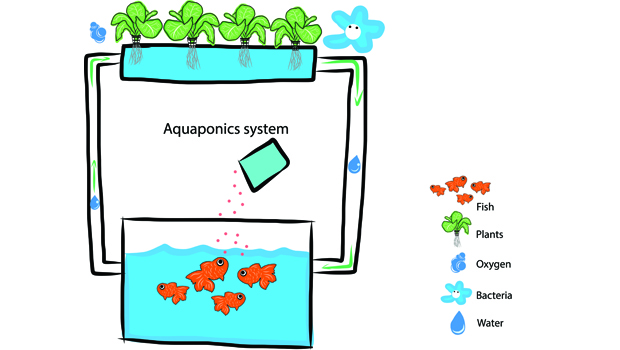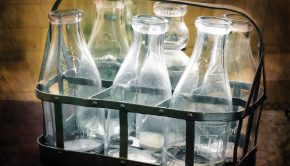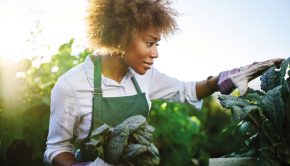Food Revolution in a Tank
Aquaponics Offers Year-Round Homegrown Fish and Veggies
Picture a salad of mixed lettuces or romaine accented with microgreens and ripe, red tomatoes alongside an entrée of tilapia, complemented by a dessert of fresh strawberries—all organic, eco-friendly and freshly harvested, even in the middle of winter. The ingredients for this meal don’t have to travel many miles to reach the table—they can be found just several feet away, thanks to aquaponics.
“Aquaculture is fish farming, hydroponics is soilless gardening,” explains Becca Self, executive director of educational nonprofit FoodChain, in downtown Lexington, Kentucky. “Aquaponics is a mutually beneficial blend of the two. Our indoor aquaponics system produces about 150 pounds of fresh tilapia every month, plus nearly 200 pounds of lettuces, herbs and microgreens.”
FoodChain, which shares production space in a former bread factory with Smithtown Seafood and West Sixth Brewing, hosted 2,000 guests and was the destination for 54 field trips last year by farmers, church groups, Rotary clubs and students of all grade levels. The seafood restaurant’s website notes, “We can step outside our back door into the farm for our superfood salad greens, herbs and tilapia.”
FoodChain is also finding a way to use waste grain from the microbrewery as fish food. According to brewmaster Robin Sither, the grain is free of genetic engineering, but not organic. He notes that it’s rare for a brewery to use organic grain.
The general hydroponics concept dates back to ancient practices in Chinese rice fields, Egyptian bottomlands flooded by the Nile River and Aztec floating gardens perched on low rafts layered with rich bottom muck. By the early 20th century, chemists had identified solutions of 13 specific nutrients which, added to water, could entirely substitute for fertile soil. That’s when William F. Gericke, Ph.D., of the University of California-Berkeley, took the science of hydroponics into commercial production.
“In today’s space-efficient, closed, recirculating aquaponic systems that combine fish tanks and plant troughs, fish waste provides fertilizer for the plants, while the plants clean the water for fish,” says Gina Cavaliero, owner of Green Acre Aquaponics, in Brooksville, Florida. The 2013 Aquaponics Association Conference, in Tucson, Arizona, reported that aquaponic plants grow faster and offer higher yields, plus the sustainable technology recycles 90 percent of the water.
In Denver, JD Sawyer, president of Colorado Aquaponics, operates a 3,000-square-foot farm in a food desert neighborhood (without easy access to fresh, healthy, affordable food). Koi, tilapia and hybrid striped bass fertilize romaine, bib lettuce, kale, Swiss chard, spinach, chives and strawberries. Other crops include tomatoes, peppers, yellow squash and root vegetables like beets and carrots. Tilapia and bass sell to the community and restaurants; koi are used in livestock ponds.
Sawyer remarks, “An aquaponics system can be indoors or out, depending on the climate, for commercial use or in the home. The basement, garage or a spare room is ideal for growing your own food.” Home garden sizes range from a 20-gallon aquarium to a 10-by-20-foot area.
Avery Ellis, an ecological designer and permaculture specialist in Boulder, Colorado, builds dynamic, living, nonconventional systems. “The temperature in most homes is near 70 degrees, an ideal temperature for a tropical fish like tilapia,” he says. “A 50-gallon fish tank, a 50-gallon storage bin and a timer to feed the fish automatically and supply light can be a self-sustaining system.”
Outdoors, a greenhouse or geodesic dome can house the system. “A harmonious balance maintains itself, and we enjoy maximum yields from little labor,” says Ellis. He reflects that the solutions for feeding the world exist if we just open our eyes to what needs to be done. For those that don’t care to harvest and clean fish, decorative koi species work well.
Erik Oberholtzer, founder and owner of Tender Greens restaurants, which sources from nearby southern California farms and is exploring ways to install an aquaponics system in each of its restaurants, explains, “The world is suffering from a loss of growing habitat, genetically modified seeds and global warming. Aquaponics enables growers to stay ahead of climate change, making it the future of sustainable farming. It’s an ethical way to make quality food healthy, affordable and profitable.”
Aquaponics methods deliver fish free of mercury and genetically modified fish food, plus the freshest vegetables possible, all without the worry of weeds, rabbits, insects, suspect fertilizers, toxic herbicides and pesticides. A home aquaponics system can be one of the best green investments to make in 2014. According to Oberholtzer, “Eating this way should not be a luxury.”
Avery Mack is a freelance writer in St. Louis, MO. Connect via AveryMack@mindspring.com.

Aquaponics Advantages
- Enthusiasts can start small
- No soil is needed
- No fertilizer is needed (provided by the fish)
- No toxic pesticides
- Uses 90 percent less water than conventional methods
- Plants help filter indoor air
- Pests and diseases are easier to spot for treatment
- Growing basil helps repel pests
- Operator controls nutrition levels at less cost and waste
- No nutrients pollute the larger environment
- Stable, high yields of organic produce and safe-fed fish
- Year-round production from indoor systems
- Easy to harvest; fish harvesting is optional
- Aesthetic enjoyment
Sources: Wikipedia.org, IntegratedAquaponics.net
<












